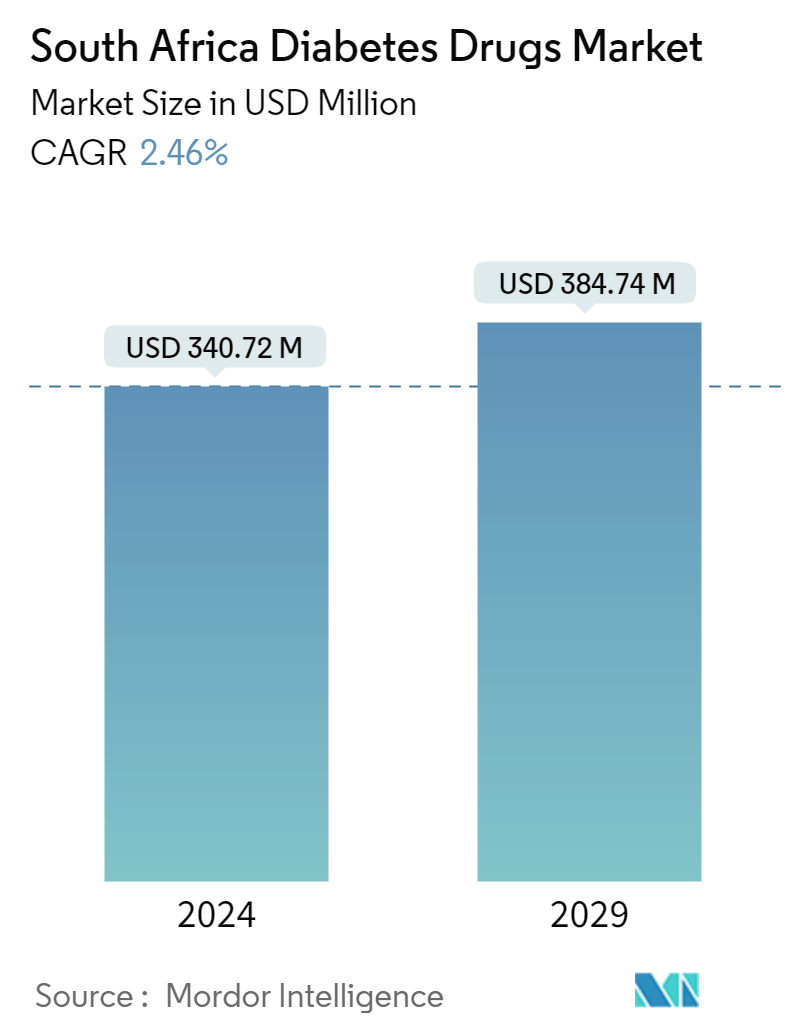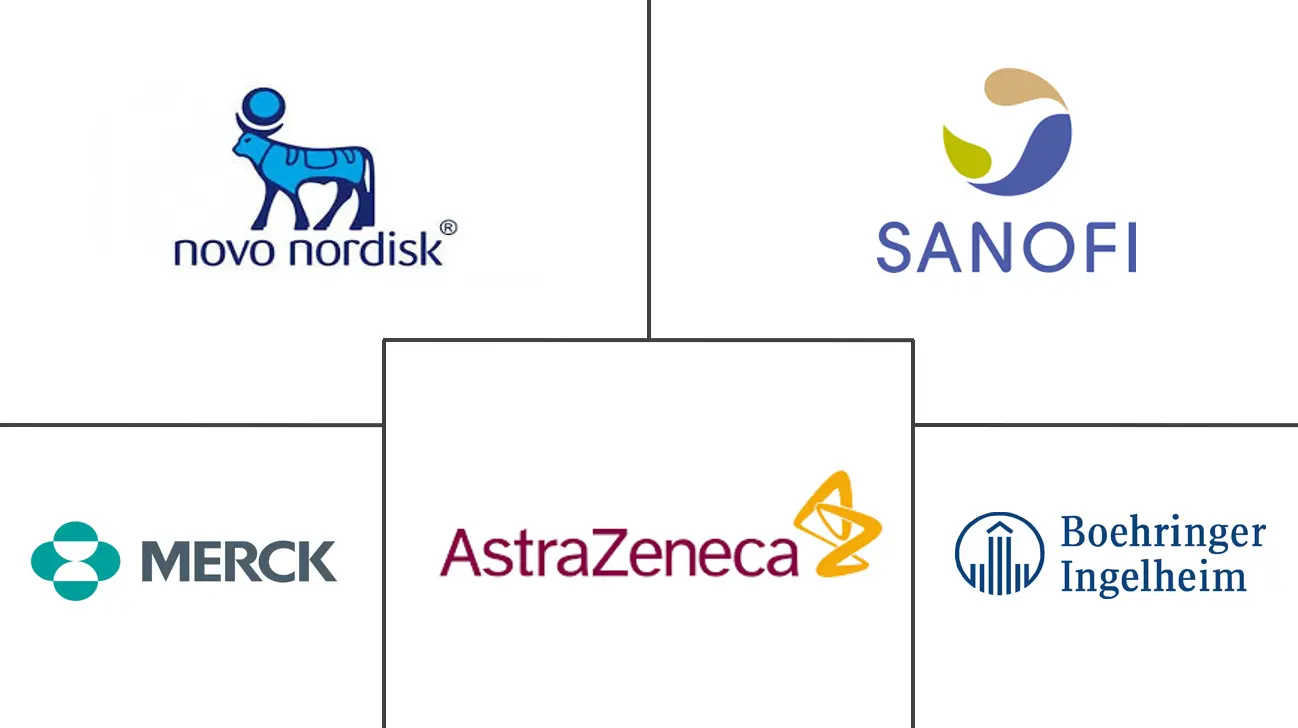Market Size of South Africa Diabetes Drugs Industry

| Study Period | 2018 - 2029 |
| Base Year For Estimation | 2023 |
| Forecast Data Period | 2024 - 2029 |
| Market Size (2024) | USD 340.72 Million |
| Market Size (2029) | USD 384.74 Million |
| CAGR (2024 - 2029) | 2.46 % |
Major Players
*Disclaimer: Major Players sorted in no particular order |
South Africa Diabetes Drugs Market Analysis
The South Africa Diabetes Drugs Market size is estimated at USD 340.72 million in 2024, and is expected to reach USD 384.74 million by 2029, growing at a CAGR of 2.46% during the forecast period (2024-2029).
South Africa is currently witnessing a troubling rise in the demand for diabetes drugs, which mirrors the increasing prevalence of diabetes within its population. As the nation deals with the challenges of urbanization and lifestyle changes, the incidence of diabetes has reached alarming levels, requiring an urgent response from healthcare authorities and policymakers.
South Africa encounters numerous obstacles in effectively managing the diabetes epidemic, despite its ongoing efforts. The complexity of the issue is exacerbated by limited healthcare access, discrepancies in healthcare provision between urban and rural regions, and socioeconomic factors like poverty and unemployment. Additionally, the exorbitant prices of diabetes medications create a significant hurdle for treatment, especially for individuals belonging to marginalized communities.
In light of the increasing incidence of diabetes, there has been a proportional rise in the need for diabetes treatments throughout South Africa. Oral hypoglycemic agents, insulin formulations, and other supplementary therapies have become essential resources in diabetes management, aiding patients in achieving glycemic regulation and reducing the likelihood of complications.
Pharmaceutical firms have acknowledged the surge in demand for diabetes medications and have extended their manufacturing capabilities to address this requirement. Furthermore, healthcare professionals are striving to enhance the availability of these treatments, especially in underserved rural regions where healthcare facilities may be scarce.
Thus, the increasing diabetes population is driving diabetes drugs in south africa market.
South Africa Diabetes Drugs Industry Segmentation
Diabetes Drugs are used to manage diabetes mellitus by lowering the glucose level in the blood. The South Africa Diabetes Drugs Market is segmented into drugs (insulin drugs (basal or long-acting insulins, bolus or fast-acting insulins, traditional human insulins, and biosimilar insulins), oral anti-diabetic drugs (Biguanides, Alpha-Glucosidase inhibitors, Dopamine D2 receptor agonist, SGLT-2 inhibitors, DPP-4 inhibitors, Sulfonylureas, and Meglitinides), non-insulin injectable drugs (GLP-1 receptor agonists and Amylin Analogue), and combination drugs (insulin combinations and oral combinations)). The report offers the value (in USD) and volume (in units) for the above segments.
| Oral Anti-diabetic drugs | ||||||
| Biguanides | ||||||
| Alpha-Glucosidase Inhibitors | ||||||
| Dopamine D2 receptor agonist | ||||||
| ||||||
| ||||||
| Sulfonylureas | ||||||
| Meglitinides |
| Insulins | |||||||
| |||||||
| |||||||
| |||||||
|
| Combination drugs | |||||
| |||||
|
| Non-Insulin Injectable drugs | |||||||
| |||||||
|
South Africa Diabetes Drugs Market Size Summary
The South Africa Diabetes Drugs Market is experiencing a notable expansion, driven by the increasing prevalence of diabetes within the country. This rise in demand for diabetes medications is a response to the challenges posed by urbanization and lifestyle changes, which have contributed to a significant increase in diabetes cases. Despite efforts to manage this epidemic, South Africa faces hurdles such as limited healthcare access, disparities between urban and rural healthcare provision, and socioeconomic factors like poverty and unemployment. The high cost of diabetes medications further complicates treatment accessibility, particularly for marginalized communities. As a result, there is a growing need for effective diabetes treatments, including oral hypoglycemic agents and insulin formulations, to help patients manage their condition and reduce the risk of complications.
Pharmaceutical companies are responding to the surge in demand by expanding their manufacturing capabilities and enhancing the availability of diabetes treatments, especially in underserved rural areas. The market is moderately consolidated, with major players like Sanofi, Novo Nordisk, and AstraZeneca holding significant shares. These companies are engaging in strategy-based mergers and acquisitions to strengthen their market presence and explore new revenue streams. Additionally, organizations such as Diabetes South Africa and SEMDSA are actively working to improve diabetes care and treatment standards. The South African government's initiatives, such as the implementation of a sugar tax and the Diabetes Prevention Programme, aim to reduce diabetes prevalence through education and healthier lifestyle choices. These factors collectively contribute to the anticipated growth of the diabetes drugs market in South Africa over the forecast period.
South Africa Diabetes Drugs Market Size - Table of Contents
-
1. MARKET DYNAMICS
-
1.1 Market Overview
-
1.2 Market Drivers
-
1.3 Market Restraints
-
1.4 Porter's Five Forces Analysis
-
1.4.1 Bargaining Power of Suppliers
-
1.4.2 Bargaining Power of Consumers
-
1.4.3 Threat of New Entrants
-
1.4.4 Threat of Substitute Products and Services
-
1.4.5 Intensity of Competitive Rivalry
-
-
-
2. MARKET SEGMENTATION
-
2.1 Oral Anti-diabetic drugs
-
2.1.1 Biguanides
-
2.1.2 Alpha-Glucosidase Inhibitors
-
2.1.3 Dopamine D2 receptor agonist
-
2.1.4 SGLT-2 inhibitors
-
2.1.4.1 Invokana (Canagliflozin)
-
2.1.4.2 Jardiance (Empagliflozin)
-
2.1.4.3 Farxiga/Forxiga (Dapagliflozin)
-
2.1.4.4 Suglat (Ipragliflozin)
-
-
2.1.5 DPP-4 inhibitors
-
2.1.5.1 Onglyza (Saxagliptin)
-
2.1.5.2 Tradjenta (Linagliptin)
-
2.1.5.3 Vipidia/Nesina(Alogliptin)
-
2.1.5.4 Galvus (Vildagliptin)
-
-
2.1.6 Sulfonylureas
-
2.1.7 Meglitinides
-
-
2.2 Insulins
-
2.2.1 Basal or Long Acting Insulins
-
2.2.1.1 Lantus (Insulin Glargine)
-
2.2.1.2 Levemir (Insulin Detemir)
-
2.2.1.3 Toujeo (Insulin Glargine)
-
2.2.1.4 Tresiba (Insulin Degludec)
-
2.2.1.5 Basaglar (Insulin Glargine)
-
-
2.2.2 Bolus or Fast Acting Insulins
-
2.2.2.1 NovoRapid/Novolog (Insulin Aspart)
-
2.2.2.2 Humalog (Insulin Lispro)
-
2.2.2.3 Apidra (Insulin Glulisine)
-
-
2.2.3 Traditional Human Insulins
-
2.2.3.1 Novolin/Actrapid/Insulatard
-
2.2.3.2 Humulin
-
2.2.3.3 Insuman
-
-
2.2.4 Biosimilar Insulins
-
2.2.4.1 Insulin Glargine Biosimilars
-
2.2.4.2 Human Insulin Biosimilars
-
-
-
2.3 Combination drugs
-
2.3.1 Insulin combinations
-
2.3.1.1 NovoMix (Biphasic Insulin Aspart)
-
2.3.1.2 Ryzodeg (Insulin Degludec and Insulin Aspart)
-
2.3.1.3 Xultophy (Insulin Degludec and Liraglutide)
-
-
2.3.2 Oral Combinations
-
2.3.2.1 Janumet (Sitagliptin and Metformin)
-
-
-
2.4 Non-Insulin Injectable drugs
-
2.4.1 GLP-1 receptor agonists
-
2.4.1.1 Victoza (Liraglutide)
-
2.4.1.2 Byetta (Exenatide)
-
2.4.1.3 Bydureon (Exenatide)
-
2.4.1.4 Trulicity (Dulaglutide)
-
2.4.1.5 Lyxumia (Lixisenatide)
-
-
2.4.2 Amylin Analogue
-
2.4.2.1 Symlin (Pramlintide)
-
-
-
South Africa Diabetes Drugs Market Size FAQs
How big is the South Africa Diabetes Drugs Market?
The South Africa Diabetes Drugs Market size is expected to reach USD 340.72 million in 2024 and grow at a CAGR of 2.46% to reach USD 384.74 million by 2029.
What is the current South Africa Diabetes Drugs Market size?
In 2024, the South Africa Diabetes Drugs Market size is expected to reach USD 340.72 million.

